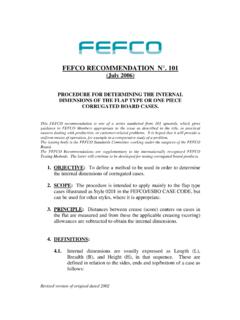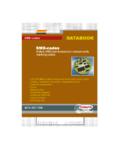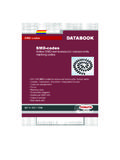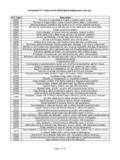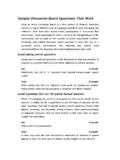Transcription of International fibreboard case code - FEFCO
1 International fibreboard case codeCode International pour emballage cartonInternationaler code f r versandverpackungen Codice internazionale per imballaggi in cartone ondulatoC digo internacional para cajas de cart n ondulado23 International fibreboard case codeInternationaler code f r versandverpackungenCode International pour emballage cartonCodice internazionale per imballaggi in cartone ondulatoC digo internacional para cajas de cart n ondulado4 PUBLISHED BY FEFCOA venue Louise Copes van Cattenburch BOX 85612NL-2508 CH The by ICCA, the International Corrugated case Association, with its worldwide ICCA, dem Internationalen Verband der Wellkistenhersteller, weltweit par ICCA, l Association Internationale des Fabricants de Carton Ondul , sur le plan da ICCA, l Associazione Internazionale dei produttori di cartone ondulato, con la sua appartenenza a livello por ICCA, la Asociaci n Internacional de Cajas de Cart n Ondulado, con sus asociados a nivel mundial.
2 2007, 11th Edition All rights reserved5 This Code has been developed by FEFCO and ESBO as an official system to substitute long and complicated verbal descriptions of fibreboard case and packaging constructions with simple symbols internationally understood by all, regardless of language and other differences. The references may be used in orders and specifications for packing cases. Additions and modifications may only be made by FEFCO and fibreboard case codeDrawing symbol Computer codeDescription Cuts, scores, slits etc. CLcontours of erected cases or cutting lines of case blanks SCslotted cutsCIcrease lines (inward bend)COcrease lines (outward bend)SIslit-score lines (inward bend)SOslit-score lines (outward bend)
3 DSdouble-score linesPLperforation lines SEsoft edge cutting lines TPtear perforation Manufacturer s jointSJstitched JointGJglued joint Openings PChandholds strippedUChandholds non-stripped NChandholds non-strippedFlute direction FDflute direction indicator Symbols used in drawings and computer systems6 case dimensionsUnless otherwise specified all dimensions are expressed as internal dimensions in mm as follows: Length (L) x Breadth (B) x Height (H) Length (L) = the longer dimension at the opening Breadth (B) = the shorter dimension at the openingHeight (H) = the dimension from the top of the opening to the base The dimensions L, B, H are specified in each description of the case construction, for some models the numerical value of B can exceed the numerical value of L.
4 Dimensions should be measured under standard climatic conditions, on the flat blank from the centre of crease bearing the thickness of the material in mind. For telescope-type boxes the height (h) of the upper part (lid) should be given as a fourth measurement after an oblique stroke, 355 x 205 x 120/40 mm (L) (B) (H) (h) For cases with overlapping outer flaps the length of the area of overlapping (o) should be given as a fourth measurement after an oblique stroke, 355 x 205 x 120/40 mm (L) (B) (H) (o) Sheet dimensions Unless otherwise specified, the dimensions of a corrugated sheet are expressed in mm as follows.
5 1st dimension x 2nd dimension 1st dimension = along the glue lines2nd dimension = across the glue lines Style versions Several case types may have derived versions without the necessity to create a new style. In this case a suffix should be added to the basic style number, separated by a dash. Example: 0201-2. A version may be unique to individual manufacturers. Combination of types The construction styles shown are of the basic types of fibreboard cases. If the ultimate construction is a combination of two or three basic models, flap arrangements, they may also be described as follows: Top flaps as 0204, Bottom flaps as 0215 This type may also be described as 0204/0215 (Top flaps.)
6 Bottom flaps). Styles and the manufacturers joint The drawing style layouts as shown in this Code may need to be re-arranged depending on the Manufacturers Joint chosen. Some styles may have a Manufacturers Joint which may be glued, stitched or taped. A glued or stitched Joint may be an extension of either the short or the long panel. The sketches show how these would be indicated on a drawing: Example for all styles:This applies to all designs in this Code. Manual or Automated erectionEach design style includes one of the following indications: M - usually manual erection A - usually automated erection M/A - can be either manual or automated M+A - requires a combination of both This indications are based on current practice and are intended to give additional information to specifiers and users.
7 Some manually erected cases can be closed automatically ( : 0216 or 0712) The layouts of the styles in this Code are always viewed from the inside of the case . 0204 0215 0204/0215 Taped joint Glued or stitched joint02017 General remarks Please note that several case designs contained in the Code under a specific number could also be classified under other basic type groups. 01 - Commercial rolls and sheets 02 - Slotted-type boxesSlotted-type boxes consist of basically one piece with a glued, stitched or taped manufacturers joint and top and bottom flaps.
8 They are shipped flat, ready to use and require closing using the flaps provided. 03 - Telescope-type boxesTelescope-type boxes consist of more than one piece and are characterised by a lid and/or bottom telescoping over the body of the box. 04 - Folder-type boxes and traysFolder-type boxes and trays usually consist of only one piece of board. The bottom of the box is hinged to form two or all side walls and the cover. Locking tabs, handles, display panels etc., can be incorporated in some designs. 05 - Slide-type boxesSlide-type boxes consist of several pieces of liners and sleeves sliding in different directions into each other.
9 This group also includes outside sleeves for other cases. 06 - Rigid-type boxesRigid-type boxes consist of two separate end pieces and a body and require stitching or a similar operation before they can be used. 07 - Ready-glued casesReady-glued cases consist of basically one piece, are shipped flat and ready to use by simple setting up. 09 - Interior fitments Interior fitments such as inside liners, pads, partitions, dividers etc., whether tied to case Design or as singular items. Any shown number of panels is arbitrary and may be increased or decreased as required.
10 Writing of the style codeDescription of basic type groups**The terms Box, Container and case are interchangeable in the context of these descriptions. Full code: XXXX-XXXX Style Style version XXXX-XXXXThe standard recognised shape/design from this code. The version number to differentiate the variation from the standard design (corresponding to an individual drawing or CAD/CAM library).8 Correct and effective closure of the packages is as important as the packaging construction itself. The following methods of closure are possible either singly or in combination: by gluing, cold or hot by taping by interlocking by stitching Closing by tapingThis can be done according to the examples shown.
